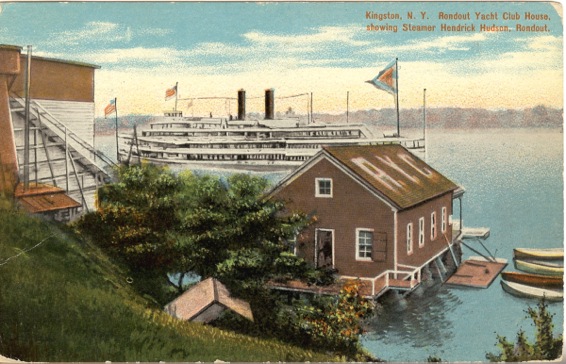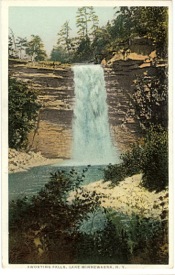
The Flow of History
Spring 2014
|
Ulster County is a place of aqua-plenty. Sometimes, far too much. Most of the time however, water has positively shaped our lives as producers, consumers, recreationists, musicians and artists, students, and lovers of beauty. From its rivers, streams, vernal pools, cave lakes, Binnewaters, canals, and wetlands, we have so much water that we send millions of gallons a day to New York City. The Ulster County government website tells us, “…The westernmost portion of the County is often referred to as the “birthplace of American fly fishing” because of the pristine headwaters of the Neversink, Beaverkill, Rondout, and Esopus Creeks. Two major reservoirs (the Ashokan and Rondout) provide the City of New York with unfiltered drinking water, and of course the Hudson River provides not only ample recreational opportunities, but also continues to serve as an important route for commerce.” Historically speaking, water has shaped much more than our terrain. Early on it slaked our thirst; gave mankind easy travel and trade routes; water for crop irrigation; mill power for industry; vistas of beauty; recreational options; food from fish and other game; and beaver, mink, and other fur bearers to clothe us. Unfortunately, for several generations it also was a convenient way to remove our sewage, trash, and industrial waste. Historically speaking, water has shaped much more than our terrain. Early on it slaked our thirst; gave mankind easy travel and trade routes; water for crop irrigation; mill power for industry; vistas of beauty; recreational options; food from fish and other game; and beaver, mink, and other fur bearers to clothe us. Unfortunately, for several generations it also was a convenient way to remove our sewage, trash, and industrial waste. As affluence exacerbated the problem, more affluence eventually mitigated it, and for the most part, has brought it under control. Sixty years ago, the Hudson was a malodorous, festering gorge running from Albany to New York City. Today, jet skiers throw up rooster tails of water discolored, if at all, by silt from recent rains. According to Captain Jeff of the Mystere tour boat berthed in Poughkeepsie, the sturgeon, once hailed as Albany beef, is again seen with some regularity by his passengers. The raven, the osprey, and bald eagle again hunt its waters. Bounding the Town of Esopus, waterways create a peninsula, the sides dipping in the east into the Hudson, to the north the Rondout, and on the west in the Wallkill River. The Ashokan and Rondout reservoirs are man made, but the water has always been there, once simply freer to run to the Hudson and the sea beyond. This plentiful water has been a boon to most and to some less so. Creation of the New York City reservoir system with its use of eminent domain removed many a village, cemetery, farm, and family, and left a very angry relocated populace in many instances.  View Above Ashokan Reservoir Today, the enmity goes on as New York City’s restrictions on land use continue to rankle locals’ sense of fairness, and curtails their use of the land. To avoid the necessity of building an eight billion dollar filtration plant, the city has done its utmost to prevent any undesirable run off into the reservoirs. To the Department of Environmental Preservation’s credit, some of its five major reservoirs now allow some restricted recreational use for fishing and kayaking, and they have purchased land use easements to control building or other uses. The reservoir system is again disrupting life in Ulster County, but not terribly… yet. A large project to improve the Catskill aqueduct will mean some of the towns currently using its water will be cut off temporarily as the work progresses. Of the approximately nine million beneficiaries of the reservoir system, about one million do not live in New York City. The 7,000 residents of the Village of New Paltz are at one of the reservoir system’s spigots that will be turned off in 2016 for the aqueduct repair. Among other ideas, the Village Trustees have investigated water sources in the neighboring Town of Lloyd which has abundant water and the Hudson River as a back up supply. New Paltz is also considering drilling wells to feed its reservoir system in the Shawangunk foothills.  Rondout Ferry Transport The recorded history of the “majestic” Hudson River is amply covered elsewhere. But some little gems are worth noting here. Early ferry service between the east and west shores included terminals for Newburgh- Beacon, Highland-Poughkeepsie, and Kingston-Rhinecliff. The ferry pictured is the Transport which looks similar to the Highland-Poughkeepsie ferry, Brinckerhoff. When the Mid-Hudson Bridge opened in 1930, the Brinckerhoff’s days were numbered. The sidewheeler was built just down river in Newburgh, NY, in 1899, and had begun operation that same year. On December 31, 1941, she went to Bridgeport, CT as a shuttle ferry between Bridgeport and Pleasure Beach. She served there until 1949. Linda Smith, a Highland resident, and granddaughter of Brinckerhoff Captain William Tompkins provided some of the information used in this article as well as the photo of Tompkins inside the Brinckerhoff.  Captain William E. Tompkins In 1950, the Brinckerhoff was given to the Mystic Seaport maritime museum in Mystic, CT. Their interest in her was probably inspired by her unique Fletcher walking-beam engine. She was eventually scrapped.  Brinckerhoff Ferry at Poughkeepsie And now for a little human interest aka gossip…Even before the ferry Brinckerhoff was a household word, the Brinckerhoff name was very much in the news. An article from the New York Times of June 24, 1886, recounts the very public divorce proceedings of the wealthy Brinckerhoff’s. The article cites Mrs. Louise Brinckerhoff’s claim that her husband was worth over $400,000. “The case excites much interest in the Hudson River Valley, as the Captain is a well known steamboat man, being Vice President of the Poughkeepsie Transportation Company, part owner of the steamer Mary Powell and owner of the ferry at this place.” On July 28th 1886, the court denied her divorce citing lack of evidence. Louise had claimed a corespondent and named one “Ida Crum.” Several witnesses corroborated Louise’s claim. Another New York Times article, dated December 3, 1901 announces the death of the Captain from a brain injury at age 75, and tells us he was survived by a brother and his adopted daughter, Miss Ida Crum, “…who lived with him for a number of years.” Locally, the Brinckerhoff had hauled people, horses, carriages, wagons, cars, food and other goods between the two Hudson shore terminals. The last to guide the Brinckerhoff was 25-year veteran, H.E. Baker of Poughkeepsie, who took her on her final voyage to Mystic. The best book on the ferry service between Highland and Poughkeepsie is Glendon Moffit’s To Poughkeepsie and Back, (1994, Purple Mountain Press). History partially repeats itself, as passenger ferry service has been restored to Newburgh-Beacon (and begins again in the Spring after its Winter hiatus) with the trip of about 10 minutes. (mta.info or call 511). Can’t take your horse and wagon, or auto though.  Awosting Falls Water was often the reason many wanted to come from Poughkeepsie to Highland. From Highland they could take the trolley to New Paltz and thence by carriage to the Mohonk and Minnewaska Mountain Houses. At Minnewaska, Awosting Falls was, and is, a draw for local and tourist alike. Mohonk as seen in the postcard in 1880 had a different tower on its cliff than the Smiley memorial that is there today. Minnewaska hotels are gone, but its glacial sky lake and Mohonk’s retain their pristine allure.  Lake Mohonk 1880 The waters of Ulster County differ in purity by wide margins. The north flowing Wallkill picks up unwanted impurities in its long journey up from New Jersey, and the Hudson has its share of spills and overflows, but generally speaking the value of clean water has soaked into the civic consciousness. Helping that consciousness is the renewed popularity of nature writers like Esopus’ John Burroughs who took the most humble bird, fish, frog, insect, or plant and made them positively mesmerizing. The coveted 2014 John Burroughs Medal for nature writing will be awarded (April 7th) at the American Museum of Natural History in New York. At this writing, the title has not been made public, but the book is sure to delight given the rigor of the judging panel. (JohnBurroughsAssociation.org). Our local history’s strong connection to water has changed the course of lives, battles, economies, and futures. That it has also whetted the appetite for more interest in our history is vital… An African saying sums it perfectly: “If you know your history, you will not fear the future.”
 Rosendale Lock |
